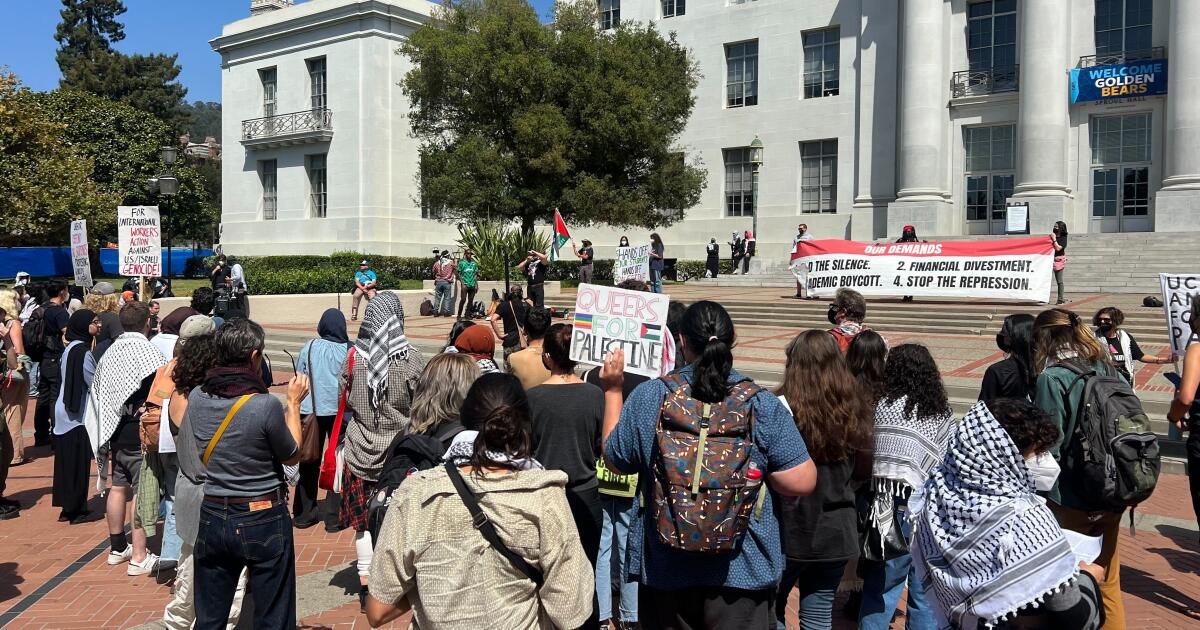MEXICO CITY — The discovery in March of a “death ranch” in western Jalisco state sparked a national outcry: Some labeled it “Mexico’s Auschwitz” after civilian searchers found charred bones and what appeared to be makeshift crematoria.
Piles of abandoned shoes, backpacks and clothing became vivid symbols of Mexico’s crisis of the disappeared, now officially numbering more than 120,000 vanished individuals, most presumed victims of organized crime.
This photo released by the Jalisco state attorney general’s office shows shoes found at Rancho Izaguirre, a cartel training site.
(Associated Press)
Mystery has continued to swirl about the site — and, on Tuesday, Mexican Atty. Gen. Alejandro Gertz Manero briefed journalists on the long-awaited findings of the federal investigation.
But his responses left more questions than answers about the grisly find that garnered both domestic and international headlines — and became an embarrassment for the government of President Claudia Sheinbaum, who vowed that Mexicans would know “the truth” about what went on at the ranch.
Gertz confirmed that the ranch — situated in an agricultural zone about 37 miles outside Guadalajara, Mexico’s second largest city — had operated as a training and operations hub for the Jalisco New Generation Cartel, among Mexico’s most powerful criminal syndicates.
But a forensic investigation found “not a shred of proof” that corpses were burned at the site, Gertz told reporters, dismissing the notion that the ranch had been a cartel extermination center.
The origins of the charred bones found at the locale, known as Rancho Izaguirre, remained unclear, and Gertz said forensic analysis was continuing. No bodies or complete sets of bones were found, he said.
The attorney general’s findings drew criticism from advocates for the disappeared.
“I feel great indignation with the attorney general and with President Sheinbaum for this insult against us and so many families who believed there would be a real investigation,” said Raúl Servín, a member of the group Warrior Searchers of Jalisco, whose visit to the site in March triggered the public outcry about the ranch. “This is a great deception.”
Federal investigations were still trying to determine why authorities in Jalisco state took no action for years, despite indications that the cartel had been operating at the ranch since at least 2021.
The National Guard raided Rancho Izaguirre last September, ending its tenure as a training camp. On that occasion, according to Jalisco prosecutors, authorities arrested 10 suspects who remain in custody, though authorities have not clarified what charges they face. Investigators also found a body wrapped in plastic and freed two captives.
However, the case of Rancho Izaguirre did not explode into the public realm until last month, when a group of civilian searchers seeking traces of the disappeared entered the site and said they had found human remains and abandoned belongings.
Still opaque is the fate of the many people, some apparently recruits for the cartel, who passed through the camp.
Previously, authorities have said that many were deceived into joining the cartel ranks, often after responding to online ads offering well-paying positions as security guards and other posts. Others have speculated that they may have been willing recruits into the ranks of organized crime, which is among Mexico’s largest employers.
Since the case of the ranch broke open, authorities say, Mexican officials have shut down dozens of online sites linked to organized crime recruiting operations.
In March, Omar García Harfuch, Mexico’s security chief, told reporters that online ads from cartels offered salaries of between $200 and $600 a week — well above the $100 to $150 that many Mexicans earn in a week. Recruits were directed to bus stations, from where they were transported to the ranch, he said.
At the camp, officials said, recruits relinquished their clothing and cellphones, remained incommunicado to the outside world, and were issued uniforms and tactical boots — a process that might explain the piles of abandoned personal effects found at the site.
The recruits underwent a one-month course of physical drills and firearms training, García Harfuch said, before many were incorporated into the cartel structure. Those who refused training, or tried to escape, may have faced beatings, torture and even death, García Harfuch said.
Mexican authorities announced last month the arrest of the alleged camp ringleader, identified only as “José Gregorio N,” and known as “El Lastra” or “Comandante Lastra,” a top recruiter for the Jalisco cartel.
The many questions about the site continue to haunt many in Mexico, especially the searchers who arrived at the site in March and distributed photos of abandoned personal items, charred bones and other chilling finds.
“We found those crematoria, we found those bones,” said Servín, the Jalisco searcher. “We found evidence. And now they tell us it is not the case. One feels a great sense of impotence.”
Special correspondent Cecilia Sánchez Vidal contributed to this report.







